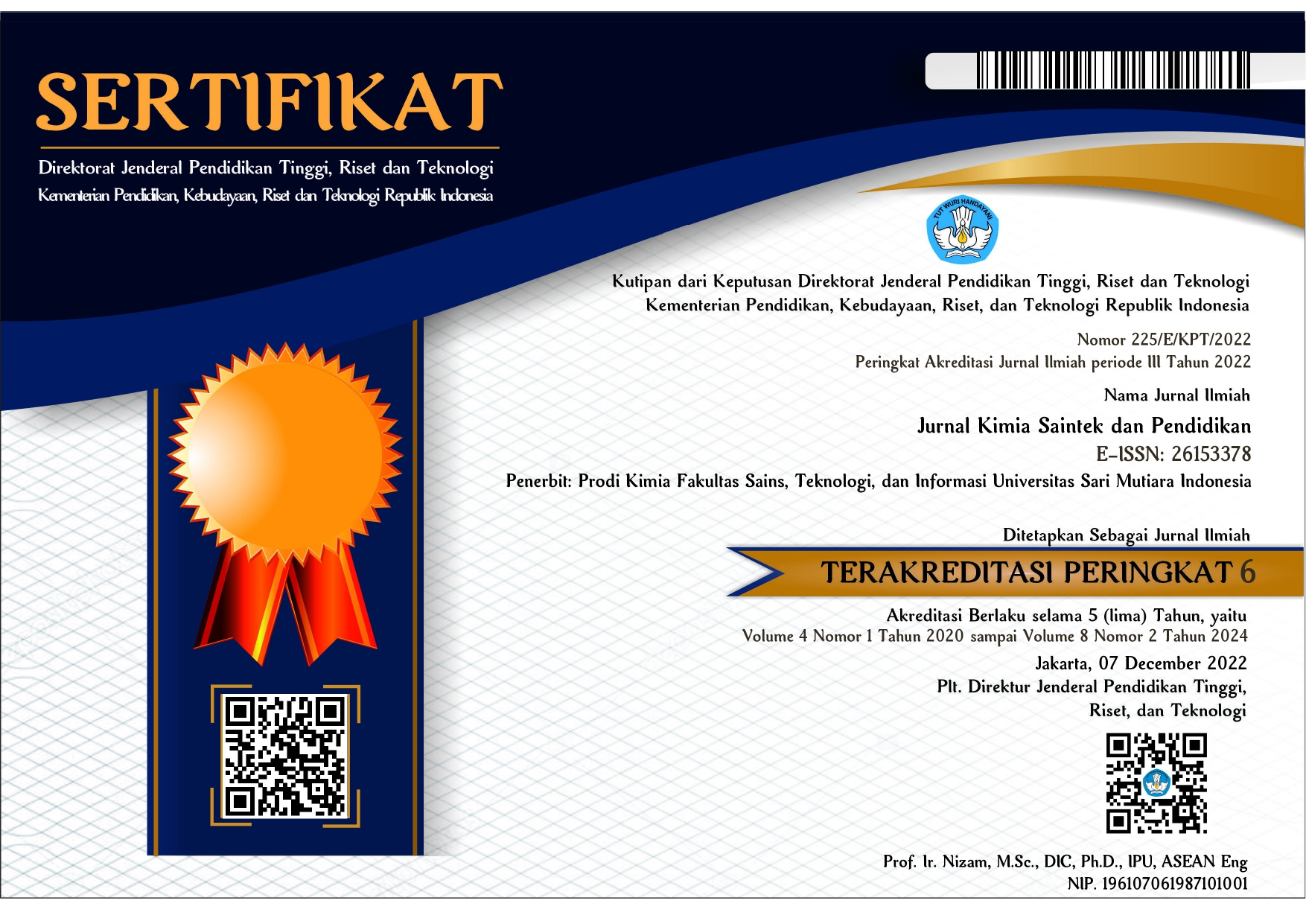SINTESIS DAN KARAKTERISASI KARBOKSIMETIL SELULOSA (CMC) DARI LIMBAH TANDAN KOSONG KELAPA SAWIT (TKKS) SEBAGAI PENGGANTI CMC INDUSTRI
DOI:
https://doi.org/10.51544/kimia.v8i1.4656Keywords:
Carboxymethyl Cellulose (CMC), Palm Empty BunchAbstract
Empty palm bunches are industrial solid waste from the manufacture of Crude Palm Oil (CPO). Currently, the number of empty palm bunches is abundant without management, so it is necessary to think about its utilization that is more useful and without causing environmental pollution. This underlies the selection of empty palm bunches as the manufacture of CMC, so as to obtain a more useful result. This study was conducted to determine how to provide Carboxymethyl Cellulose (CMC) and to determine the characteristics of Carboxymethyl Cellulose (CMC) of palm empty bunches produced. the research method of providing CMC is carried out through the process of isolation of α cellulose, delicification, swiling, bleaching, hydrolysis and the process of alkalization and carboxymethylization to produce CMC. CMC is reviewed through the parameters of Degree of Substitution, pH and purity to produce CMC that meets the requirements of SNI CMC quality 1 and SNI CMC muti II. And from the results that have been done CMC Empty Palm Bunches show results that have met the SNI standard 1. For the parameters of the Degree of Substitution 0.7990, pH 7 and purity 99.41%. And the results of FT-IR functional groups of CMC empty palm bunches get the results of O-H, C-H, C-O functional groups. .Downloads
References
F. R. Agustriono and A. N. Hasanah, “Pemanfaatan Limbah Sebagai Bahan Baku Karboksimetil Selulosa: Review,” Farmaka, vol. 14, no. 3, pp. 83–94, 2017.
D. Silsia, Z. Efendi, and F. Timotius, “Characterization of Carboxymethyl Cellulose (CMC) From Palm Midrib,” J. Agroindustri, vol. 8, no. 1, pp. 53–61, 2018, doi: 10.31186/j.agroind.8.1.53-61.
T. Heinze, O. A. El Seoud, and A. Koschella, “Production and Characteristics of Cellulose from Different Sources,” in Springer, 2018. doi: 10.1007/978-3-319-73168-1_1.
F. Dimawarnita, T. Panji, and Y. Faramitha, “Peningkatan Kemurnian Selulosa dan Karboksimetil Selulosa (CMC) Hasil Konversi Limbah TKKS Melalui Perlakuan NaOH 12%,” E-Journal Menara Perkeb., vol. 87, no. 2, pp. 95–103, 2019, doi: 10.22302/iribb.jur.mp.v87i2.339
R. Futeri, S. D. Samah, and R. P. Putra, “Pembuatan CMC (Carboxy Methyl Cellulose) dari Limbah Ampas Tebu Menggunakan Reaktor Semi Continue,” in 6th ACE Conference, 2019.
E. Putri and S. Gea, “Isolasi dan Karakterisasi Nanokistral Selulosa dari Tandan Sawit (Elaeis Guineensis Jack),” Elkawnie, vol. 4, no. 1, pp. 13–22, 2018, doi: 10.22373/ekw.v4i1.2877.
W. Nisa, “Cellulose Utilization in Cacao Pod Husk (Theobroma cacao L.) as Raw Material for CMC (carboxymethyl cellulose) Synthesis,” J. Pangan dan Agroindustri, vol. 2, no. 3, pp. 34–42, 2014.
N. Nur’ain, N. Nurhaeni, and A. Ridhay, “Optimasi Kondisi Reaksi Untuk Sintesis Karboksimetil Selulosa (CMC) Dari Batang Jagung (Zea mays L.),” Kovalen, vol. 3, no. 2, pp. 112–121, 2017, doi: 10.22487/j24775398.2017.v3.i2.8717.
Nuringtyas, Karbohidrat. Yogyakarta: Gajah Mada, 2020.
T. Sibarani, “Sintesis dan Karakterisistik CMC (Carboxymethyl Cellulose) dari Selulosa Batang Pisang Raja (Musa Paradisiaca) dengan Variasi Natrium monokloroasetat,” J. saintia Kim., vol. 1, no. 2, 2018.
Melisa, S. Bahri, and Nurhaeni, “Optimasi Sintesis Karboksimetil Selulosa dari Tongkol Jagung Manis (Zea mays l saccharatu),” Online J. Nat. Sci., vol. 3, no. 2, 2014.
Pitaloka, “Selulosa eceng gondok dengan media reaksi campuran larutan Isopropanol –Isobutanol Untuk Mendapatkan viskositas dan kemurniaan tinggi,” J. Integr. Proses, vol. 2, 2015.
A. Wijayani, K. Ummah, and S. Tjahjani, “Characterization of Carboxy Methyl Cellulose (cmc) from Eichornia crassipes (mart) solms,” Indones. J. Chem., vol. 5, no. 3, 2005, doi: https://doi.org/10.22146/ijc.21795.
Downloads
Published
Issue
Section
License
Copyright (c) 2024 Yuni Trisnawita, Elisa Putri

This work is licensed under a Creative Commons Attribution-ShareAlike 4.0 International License.











.png)

